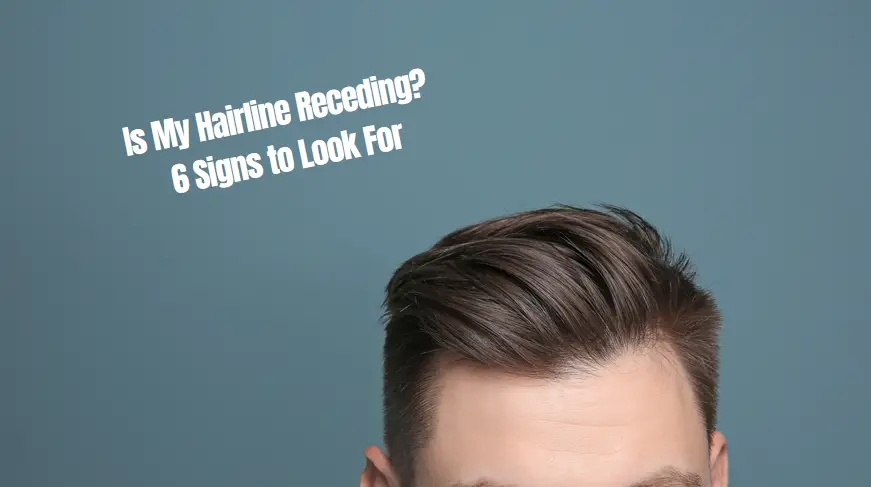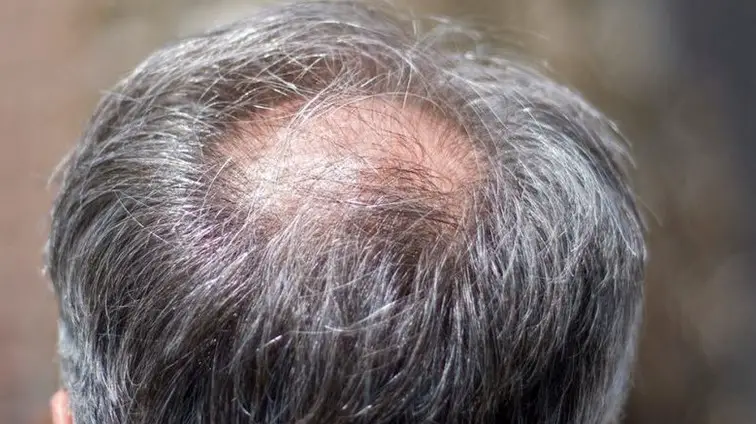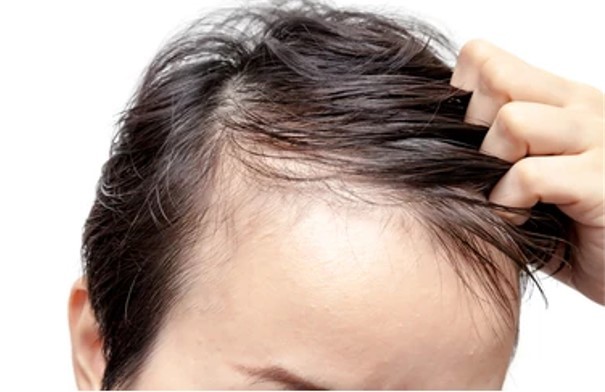How to tell if your hairline is receding is a question that many people, both men and women, find themselves asking. Hair is often considered a symbol of youth and vitality, which is why noticing a receding hairline can be a cause for concern for many.
In this comprehensive guide, we will delve into the topic of receding hairlines, helping you understand what it is, its causes, and most importantly, how to identify it. We’ll also discuss the difference between a mature hairline and a receding hairline, a distinction that often causes confusion.
Whether you’re a man noticing changes in your hairline, or a woman concerned about hair loss, this guide is designed to provide you with the information you need. So, let’s embark on this journey to understand more about receding hairlines and how to deal with them.
If you’re interested in learning more about hair loss patterns and stages, feel free to check out our article on receding hairline stages. It provides a detailed overview of the progression of hair loss, which can be a useful resource in understanding your own hair situation.
Remember, knowledge is power. The more you understand about your hair and its changes, the better equipped you’ll be to handle it. So, let’s get started!
Continue Reading: What is a Receding Hairline?
What is a Receding Hairline?
A receding hairline is a form of hair loss where the hair around the temples and forehead starts to thin and fall out, causing the hairline to move backwards. This is a common occurrence in many people as they age, and it’s often one of the first signs of male pattern baldness. However, it’s not exclusive to men; women can also experience a receding hairline, although it’s less common and usually less noticeable.
The process of a receding hairline can be gradual, often taking several years to become noticeable. It’s not uncommon for people to overlook the early signs of a receding hairline, attributing the changes to a maturing hairline or natural aging. However, understanding the difference between a mature hairline and a receding hairline can help you identify if your hairline is indeed receding.
A mature hairline refers to the natural shift in the hairline that occurs as men transition from adolescence to adulthood. This is a normal part of aging and doesn’t necessarily indicate that you’re experiencing hair loss. On the other hand, a receding hairline is characterized by a significant shift in the hairline and thinning hair, which are signs of hair loss.
If you’re unsure about the state of your hairline, it’s always a good idea to consult with a healthcare professional or a hair loss specialist. They can provide a thorough examination and give you a definitive answer.
For more information on the differences between a mature hairline and a receding hairline, check out our detailed article here, Is Mature Hairline Balding. It provides a comprehensive comparison that can help you better understand your hairline.
In the next section, we’ll delve into the causes of a receding hairline. Understanding these causes can help you take proactive measures to manage your hair health.
Causes of a Receding Hairline
Understanding the causes of a receding hairline can be a crucial step in managing and potentially slowing down the process. There are several factors that can contribute to a receding hairline, and it’s often a combination of these factors that leads to hair loss.
Genetic Factors
One of the most common causes of a receding hairline is genetics. If your parents or grandparents have experienced hair loss, there’s a good chance you might too. This is known as androgenetic alopecia, or more commonly, male or female pattern baldness.
Hormonal Changes
Hormonal changes can also play a significant role in hair loss. In men, the hormone dihydrotestosterone (DHT) can cause hair follicles to shrink, leading to thinning hair and a receding hairline. Women may also experience hair loss due to hormonal changes, particularly during menopause.
Lifestyle Factors
Certain lifestyle factors can contribute to a receding hairline. These include stress, poor nutrition, smoking, and lack of sleep. While these factors alone may not cause a receding hairline, they can exacerbate the process in individuals who are genetically predisposed to hair loss.
Medical Conditions
Certain medical conditions, such as thyroid disorders, anemia, and autoimmune diseases, can also lead to hair loss. If you’re experiencing a receding hairline along with other symptoms, it’s important to consult with a healthcare professional to rule out any underlying medical conditions.
Understanding the causes of a receding hairline is the first step towards managing it. In the next section, we’ll discuss how to tell if your hairline is receding and the signs to look out for.
For more information on the causes of a receding hairline and how to manage it, check out our detailed article here. It provides a comprehensive overview that can help you better understand your hair health.
How to Tell if Your Hairline is Receding
If you’ve been noticing changes in your hairline or the thickness of your hair, you might be wondering if you’re experiencing a receding hairline. This is a common concern for many people, especially as they age. Here are some signs that your hairline may be receding:
- Slight, uneven hair loss above your temples: This is one of the earliest signs of a receding hairline. You might notice that your hair is starting to thin or recede in this area.
- A band of lighter skin above your forehead and temples where you’ve lost hair: This is another early sign of a receding hairline. The skin in this area might appear lighter because it’s not as covered by hair as it used to be.
- Zigzag pattern or balding patches along the hairline: As the hairline continues to recede, you may notice a zigzag pattern or bald patches along the hairline.
- Changes from old photos to the present: Comparing photos of yourself from a few years ago to recent ones can help you notice differences in your hairline that might not be visible in the mirror. If your hairline appears to have moved back or changed shape, this could be a sign of a receding hairline.
- Texture changes and thinner hair: If you notice that your hair is becoming thinner and more brittle, it could be a sign of a receding hairline. Hair loss often affects the texture of the hair, making it feel thinner and less robust.
- Problems with styling your hair that you didn’t have before: If you’re having trouble styling your hair in the same way you used to, it could be because your hairline is receding. Hair loss can make it more difficult to achieve certain hairstyles.
- An M-shaped hairline or a widow’s peak: A shift to a high hairline that recedes more than 1 inch from where it was originally can result in an M-shaped hairline or a widow’s peak, which is known as a receding hairline.
- Hair on the temples recedes far more than on other parts of the scalp: This can create a “horseshoe” or “M-shape pattern” that is a tell-tale sign of a receding hairline.
- Hair starts to thin or recede from its original position: If you notice that your hair is thinning or receding from its original position, it’s a sign that hair loss in other areas may be next.
It’s important to note that hair loss or thinning hair is a normal issue that can come about for a variety of reasons, predominantly as part of the aging process. However, if you’re concerned about your hairline, it’s best to consult with a doctor or dermatologist who can provide a professional diagnosis and recommend appropriate treatments.
Differences in Hairline Recession in Males and Females
It’s important to note that hairline recession can look different in males and females. In men, a receding hairline often starts at the temples and forehead, forming an ‘M’ or ‘U’ shape. In women, hair loss tends to be more diffuse, with thinning occurring all over the scalp rather than in specific areas.
If you’re noticing any of these signs, it’s a good idea to consult with a healthcare professional or a hair loss specialist. They can provide a thorough examination and give you a definitive answer.
For more information on how to tell if your hairline is receding, check out our detailed article here. It provides a comprehensive overview that can help you better understand your hair health.
In the next section, we’ll discuss whether a receding hairline can grow back and the treatments available for hairline recession.
Can a Receding Hairline Grow Back?
One of the most common questions people ask when they notice their hairline receding is, “Can a receding hairline grow back?” The answer to this question largely depends on the cause of the hair loss.
If the hair loss is due to temporary factors such as stress, poor nutrition, or certain medical conditions, then it’s possible that your hairline could grow back once these issues are addressed. However, if the hair loss is due to genetic factors, also known as androgenetic alopecia, the process is usually permanent.
That being said, there are treatments available that can help slow down the process of hair loss and in some cases, even regrow some hair. These treatments include:
Minoxidil
Minoxidil, also known as Rogaine, is a topical treatment that is applied to the scalp. It works by prolonging the growth phase of the hair follicles, which can result in thicker hair.
Finasteride
Finasteride, also known as Propecia, is a prescription medication that works by blocking the production of the hormone DHT, which is responsible for hair loss.
Hair Transplant Surgery
Hair transplant surgery involves moving hair follicles from one part of the scalp to the area with hair loss. This is a more invasive option and is usually considered when other treatments have not been effective.
It’s important to consult with a healthcare professional or a hair loss specialist before starting any treatment. They can provide a thorough examination and recommend the best treatment option for you.
For more information on treatments for a receding hairline, check out our detailed article here. It provides a comprehensive overview of the various treatment options available.
In the next section, we’ll discuss some frequently asked questions about receding hairlines.
How to Prevent and Treat a Receding Hairline
While a receding hairline can be a natural part of aging, there are steps you can take to prevent and treat hair loss. Here are some strategies that can help:
Maintain a Healthy Lifestyle
A healthy lifestyle can have a significant impact on your hair health. This includes eating a balanced diet rich in vitamins and minerals that support hair growth, such as vitamin D, iron, and biotin. Regular exercise can also help by improving blood circulation, which can stimulate hair follicles.
Avoid Damaging Hair Practices
Certain hair practices can exacerbate hair loss. This includes tight hairstyles that pull on the hairline, excessive heat styling, and harsh chemical treatments. Try to avoid these practices and opt for gentle hair care routines instead.
Use Hair Loss Treatments
As mentioned earlier, there are treatments available that can help slow down hair loss and potentially regrow some hair. These include minoxidil and finasteride, which work by promoting hair growth and blocking the production of DHT, respectively.
Consider Hair Transplant Surgery
If other treatments have not been effective, hair transplant surgery may be an option. This procedure involves moving hair follicles from one part of the scalp to the area with hair loss. It’s a more invasive option and should be considered after consulting with a healthcare professional or a hair loss specialist.
Consult with a Healthcare Professional or a Hair Loss Specialist
If you’re noticing signs of a receding hairline, it’s a good idea to consult with a healthcare professional or a hair loss specialist. They can provide a thorough examination, confirm if your hairline is receding, and recommend the best treatment option for you.
For more information on how to prevent and treat a receding hairline, check out our detailed article here. It provides a comprehensive overview of the various strategies and treatment options available.
In the next section, we’ll answer some frequently asked questions about receding hairlines.
Frequently Asked Questions
When it comes to receding hairlines, there are many questions that people often ask. Here are some of the most common ones:
1. What age does a receding hairline start?
A receding hairline can start at any age, but it’s most common in men in their 30s and 40s. However, it can also start in the late teens or early 20s, especially in men who have a family history of hair loss.
2. Can a receding hairline grow back?
Whether a receding hairline can grow back largely depends on the cause of the hair loss. If the hair loss is due to temporary factors such as stress or poor nutrition, then it’s possible that the hairline could grow back once these issues are addressed. However, if the hair loss is due to genetic factors, the process is usually permanent. There are treatments available that can help slow down hair loss and in some cases, even regrow some hair. For more information, check out our article on hair loss treatments.
3. What’s the difference between a mature hairline and a receding hairline?
A mature hairline is a natural change in the hairline that occurs as men age, usually in their late teens or early 20s. It involves a slight recession of the hairline, especially at the temples, but does not progress further. A receding hairline, on the other hand, is a form of hair loss that continues to progress over time. For more information, check out our article on mature hairline vs receding hairline.
4. How can I tell if my hairline is receding?
There are several signs to look out for, including a change in the shape of your hairline, thinning hair, an itchy or sore scalp, and slow hair growth. If you’re noticing any of these signs, it’s a good idea to consult with a healthcare professional or a hair loss specialist. For more information, check out our article on how to tell if your hairline is receding.
5. What treatments are available for a receding hairline?
There are several treatments available for a receding hairline, including minoxidil, finasteride, and hair transplant surgery. These treatments work by promoting hair growth, blocking the production of DHT, or moving hair follicles to the area with hair loss, respectively. For more information, check out our article on treatments for a receding hairline.
Conclusion
Understanding the signs of a receding hairline and knowing how to address it can help you take control of your hair health. While it can be a natural part of aging, there are steps you can take to prevent and treat hair loss.
Remember, a healthy lifestyle, gentle hair care routines, and the right treatments can make a significant difference. If you’re noticing signs of a receding hairline, don’t hesitate to consult with a healthcare professional or a hair loss specialist. They can provide a thorough examination and recommend the best treatment option for you.
We hope this article has provided you with valuable information on how to tell if your hairline is receding and the various strategies and treatments available. For more detailed information on this topic, check out our other articles on receding hairlines and hair loss treatments.
Remember, everyone’s hair loss journey is unique, and what works for one person may not work for another. It’s all about finding the right solution for you. Keep exploring, stay informed, and don’t lose hope.
Continue Reading: Signs Of Balding At 20
References and Additional Resources
For more information on receding hairlines and hair loss, here are some additional resources and references that you might find helpful:
- American Academy of Dermatology Association: This organization provides a wealth of information on hair loss, including causes, treatments, and tips for managing hair loss. You can find more information here.
- National Institute of Health (NIH): The NIH provides scientific articles and studies on hair loss and its treatments. You can find more information here.
- Our Articles: We have a range of articles on our website that delve into different aspects of hair loss. Here are some that you might find useful:
- Male Celebrities with Receding Hairlines
- Signs of a Receding Hairline
- Receding Hairline Stages
- Minoxidil for Receding Hairline
- Widow’s Peak vs Receding Hairline
- What is a Receding Hairline?
- M-Shaped Hairline
- Before and After Hairline Laser
- Uneven Hairlines
- Vertex Scalp
- Norwood 3 Vertex
- Balding at the Crown
- Is Mature Hairline Balding?
- Thin Crown
Remember, knowledge is power. The more you understand about your hair loss, the better equipped you’ll be to manage it effectively.
- AI Powered Bald Filter Online 2024: See Yourself with No Hair! - January 19, 2024
- Harklinikken Bad Reviews 2024: Analyzing Negative Feedbacks - January 18, 2024
- How to Get the Alex Eubank Hair | Step-By-Step Tutorial 2024 - January 18, 2024







